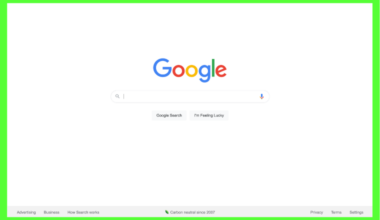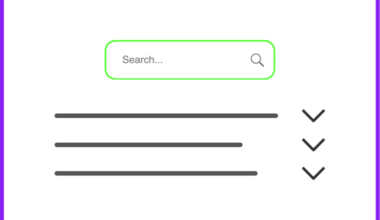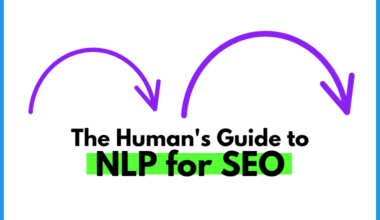Since September 2023, the SEO world has been rocked by massive upheavals in search results. Niche sites across most industries — even some of the really good ones — lost massive traffic overnight, and spam from “UGC” can be found just about everywhere.
(Pro tip: Follow Lily Ray on X. She’s constantly sharing large-scale test results from Amsive’s clients and her own observations about everything from spam to growth and decline, and it’s a huge value add to my life #tbh.)
The primary driver of this change seems to be Google’s “Helpful Content System,” and more specifically, the September 2023 Helpful Content Update (HCU). This wasn’t the first HCU, but it was definitely the one with the furthest-reaching impact.
Some of our clients felt (and are still feeling) the pain of this update. Two of them — for whom we’ve been creating well-written, well-researched, topical content for years — still haven’t recovered significantly. The worst one continues to haunt me every time I check out their stats in GSC:
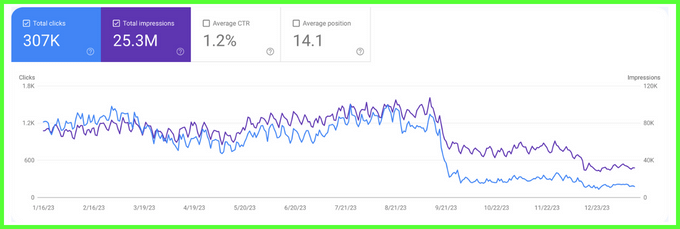
It’s not all bad news, though! We’ve been able to spot a few trends of our own and develop plans moving forward for our clients.
Here’s everything we’re doing and recommending to our own clients to help them grow with SEO in 2024.
But first: A brief recap of E-E-A-T
I know Google keeps telling us that author bios on pages aren’t a direct ranking factor (*cue eye roll*). But while that specific technical aspect may not be a big deal, the people and brands behind your website are of paramount importance.
Google added that pesky extra “E” to their E-A-T standards for quality raters in late 2022, and it’s safe to say at this point that it’s not going away.
A quick recap if you’re not familiar with E-E-A-T:
E-E-A-T, or “double-E-A-T,” stands for Expertise, Experience, Authority, and Trust, and refers to how creators meet standards for all 4 of these factors in what they publish.
This is part of what Google’s human quality raters are supposed to look for when reviewing websites manually. They’re not considered “direct ranking factors,” but that just means no one is typing some sort of quality rating about your website into Google’s algorithm — they matter greatly for how well your brand, as a whole, will be able to rank.
The standards for E-E-A-T differ greatly by topic.
- If you’re writing about how to do a particular nail polish technique, the standard is probably something like, “this person clearly demonstrates they know how to do and have completed this technique.”
- On the other hand, if someone is searching for a review on a nail polish brand, your article and website may have very little chance of ranking high on the SERP. At least as of right now, sites with a lot of UGC (user-generated content) like Reddit, Quora, and other community-based sites are the clear winners for queries about other people’s real-life experiences.
- But if you’re writing about treatment for cancer or how to invest for retirement, the standard goes up by a huge factor. To rank for these terms, your brand must be incredibly well-established online, the individual people who write for your site should be able to prove their education and expertise on the topics, and other established brands must link to you.
You’ll notice I did not say that the quality of your content matters for E-E-A-T.
Unfortunately, this is (in my opinion) one of the biggest net negatives from the September 2023 HCU — well-researched and better-structured content is losing, at least for health-related topics (our bread and butter), in favor of brands with big names (and budgets) behind them, like WebMD, Healthline, Cleveland Clinic, Mayo Clinic, etc.
Enough recapping. Let’s talk about what this means for individual sites.
You MUST have an online presence
… and it must be somewhere other than your own website.
Whatever you want to call this — public relations, link building, trust relations, relationship building — creators will fail if their only online presence is on their own website.
There’s one clear delineation between our clients who saw improvements to their traffic last fall and those who lost a significant number of visits in Fall 2023:
Brands with well-established online presences saw traffic increases, while those with minimal, outdated, or irrelevant online presences lost traffic.
To future-proof your own site, here are a few ways to build that online presence:
- Use schema markup as part of establishing your brand identity: When Googling your brand’s name, your goal should be to see a dedicated Knowledge Graph about what your brand is. It’s a little easier to do this if you’re a local business with a physical address (because your Google Business Profile essentially serves this function), but for online-only brands, there are a few other steps. I love this SEL piece on establishing a brand identity, but one major item that many brands miss is using Organization markup on their homepage or about page. (Hint: It tells Google who you are and what you do.)
- Build relationships to get mentioned: When you build relationships with journalists and other site owners, you can offer them value with relevant quotes, guest posts, and guest appearances. And it doesn’t just need to be mentions in standard written content — podcasts, videos, and social media are all great ways to build a brand identity online.
- Focus on relevant websites: Sure, the New York Times has a good DR (whatever that’s supposed to be), but many of those sites no longer offer smaller-time creators a voice and/or refuse to use actual links back to creators (thanks, backlink builders 🙄). However, you can find something relevant to your brand that might be just as beneficial. Think: Related local businesses, smaller websites that write about your area of expertise, and so on.
- Hire a PR agency: Yeah, yeah, agency shmagency… Look, it’s simply the truth that PR agencies have connections you may not have yet. You can build those on your own (which takes time and some expertise), or you can rely on an agency with existing relationships to help you along. (If you’re interested, my friend April runs Trust Relations, which is a pretty solid PR agency. Make sure to tell her I sent you, and yes, I do get a referral commission — but I’d recommend her agency even if I didn’t.)
- Don’t sleep on social media: Find the networks your audience spends time scrolling on, and create content for them. Use best practices, like closed captioning for videos, optimized descriptions, and a predictable publishing cadence.
I’ll give you a few real-life examples to show you what I mean about online presence being a huge traffic driver: (these are long, so click here to skip the examples if you just want to get to the next point)
1. A chiropractic website with around 70K organic visits/month lost 90% of its traffic overnight.
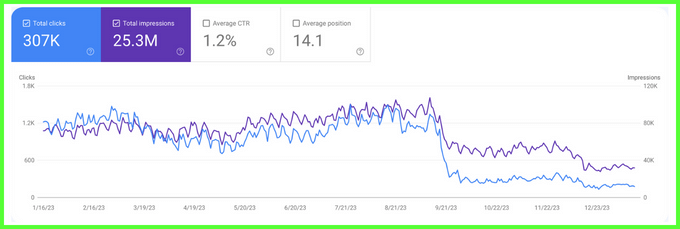
Full disclosure: My agency has created 100% of the content on this site, including the website itself.
- Content strategy: Pages about various queries about headaches, concussions, chiropractic care, orthospinology, and pain disorders best treated by chiropractic care
- Audience: Patients in the US with chronic health conditions best treated by a precise type of chiropractic care, generally people who haven’t found relief in traditional medicine or even standard chiropractic (a large number of their patients travel from out of town)
- Off-site brand presence: Minimal; a few podcast episodes and relevant mentions from multiple years ago, no other significant presence
The site’s content was incredibly well-researched and structured, reviewed in detail by the lead chiropractor before publishing. There were no display ads in sight, and the site itself was redesigned by my own team over a year and a half ago to make it a visually pleasant, easy-to-use, and fast user experience.
However, the client just doesn’t like doing PR of any kind or producing content for social media. It was a conscious choice we discussed years ago, and unfortunately, he seems to be paying for it.
2. A niche fashion website with over 200K monthly organic visits now struggles to break 15K/month.

Full disclosure: This client hired me for a consultation, so I don’t have access to their granular analytics data and wasn’t part of the aforementioned strategy or content creation. The above screenshot of their traffic dip is from Ahrefs.
- Content strategy: Pages about fashion, styling, hair, makeup, and accessories, including in-depth, personal reviews of individual products or product types
- Audience: Millennial women looking for basic fashion tips and styling advice
- Off-site brand presence: Significant, but focused on growing a niche site, making money from blogging online, and entrepreneurship (not about fashion and design)
They had a boost in early 2023, followed by a “back to normal” in the summer, then significant drops at the September HCU.
Like the first example I mentioned, this site produces awesome content. It’s not AI drivel or repetitive nonsense — this creator painstakingly defines, reviews, and structures everything on the site herself. She spends weeks or months on the reviews, which is evident in the various photos, videos, and written content on the page. Everything she creates is related to the same general topic, and honestly, the worst thing I could find was a few missing affiliate disclosures.
But the underlying thread here is that expertise and experience must be seen off your website, and unfortunately, the only recent mentions and features she had (which were plentiful) were advice on making money blogging. If you were just Googling to learn who she is, you’d believe she was a blogging expert, but not necessarily someone best qualified to provide fashion advice.
It was clear this person was excited to share her learnings in entrepreneurship with an audience that wanted to do the same. I think that, however well-intentioned, it established her as the wrong kind of “expert” in the eyes of Google.
3. A functional health brand slowly lost around 50% of its 160K/month organic clicks.
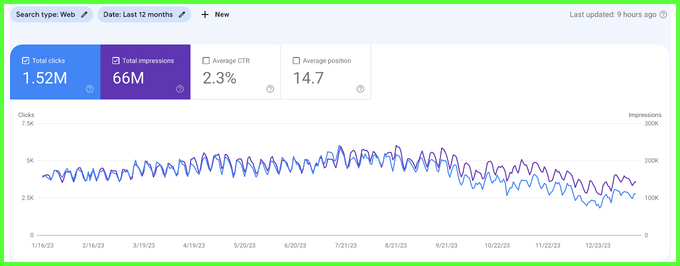
Full disclosure: This is our longest-standing client for whom we’ve been building content slowly since March 2019 (nearly 5 years). About 80% of the content on their website was created by our agency with content and review support from their team of healthcare providers.
- Content strategy: Blog pages built around the most common conditions and treatments related to their patient base, focusing heavily on longer-tail queries about natural remedies and integrative treatments; service and other static pages built around each specific type of service and testing they provide
- Audience: Split; their SEO audience is generally US-based readers seeking natural and alternative treatments and understanding of chronic health conditions, while their actual patient base is limited to residents of a single state
- Off-site brand presence: Moderate, but aging; a couple of recent podcasts, but the vast majority of off-site mentions are at least 3 years old
Interestingly, this site didn’t get crushed at the same rate as my other two examples, but I believe it’s still worth mentioning. I’m keeping an eye on growth here, because this client historically has a 4-week drop around the holidays (December 25 is their lowest traffic day every single year by a large margin).
But it’s impossible not to notice the drop around September.
Still, it could be related in part to the lack of online presence and the fact that people ranking over my client from an entire United States perspective are often those offering services to patients in many states or the entire country.
Also, the authors on this site (who are the actual people reviewing each piece of content) are varied, and only one or two of them have been mentioned regularly in other publications.
4. A niche tutoring service wins the HCU with 2x YoY traffic.
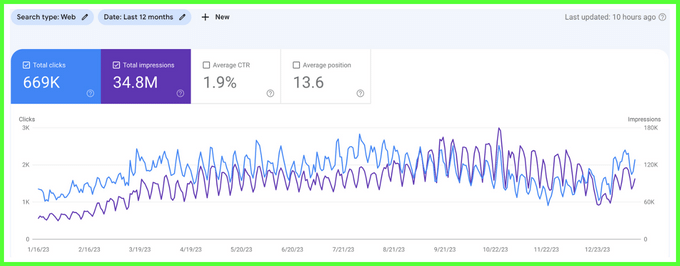
Full disclaimer: We’ve worked with this client for a little under a year and a half. We’ve optimized around 25% of the content on their site, and our optimizations are largely responsible for the traffic increases.
- Content strategy: Blogs on each broad and long-tail topic related directly to their tutoring clients; service pages for each specific tutoring offering
- Audience: US pre-med students and medical students
- Off-site brand presence: Moderate, but recent; we’re working on improving this in 2024, but one of their primary authors writes for large publications at least once a month and their leadership team is frequently featured on related podcasts and social media
This one takes a very brief explanation, as it may look at first glance like this client lost traffic around the HCU. However, their content is incredibly seasonal — their busy season is between March and August, always dropping between September and February. Year over year, they’re up by 2x the amount they were the previous year!
This client’s gains are still modest compared to what they could be, and one of our biggest goals in 2024 is to increase their brand presence in several ways. I included them as an example because they still have a long way to go with content improvements but still managed to experience a positive turn after last September.
You MUST offer something valuable apart from content
This is one aspect of the HCU that I think isn’t getting as much attention as it deserves, at least in terms of YMYL queries.
Sites like Healthline and WebMD may monetize primarily with ads, but they have fairly significant digital offerings in terms of interactive tools, email, podcasts and story series, diagnostic tools, and healthcare provider databases.
Other sites, such as Cleveland Clinic or Harvard Health, either provide in-person services related to their content or are such longstanding institutions that their authority is accepted (somewhat) without question.
(Please note that I am not saying this is a good thing. I personally take issue with the idea that companies with a lot of money or a lot of history should “win” by default, and I think the idea that the “little guy” can win is one of the things that used to make the internet great.)
Still, it might be worth considering this if you offer no services outside of helpful content. I think Google has decided it’s just “content for search engines,” which they make a big deal about avoiding.
I wrote more about this on X — join the conversation and share your thoughts!
Something I've noticed related to HCU traffic declines that I don't feel like I've seen people discuss enough:
— Rebekah Edwards | Content-Led SEO (@rebekah_creates) January 17, 2024
Sites that offer services relevant to their content are winning.
A short 🧵
You MUST prioritize helpful content
Content is still a huge factor in your brand’s SEO in 2024. While not every brand needs a blog, the content on every site should be effective, helpful, and well-crafted.
- Create content to meet your audience’s needs. This might be informational. It may be transactional. It might be a suite of digital tools or image-rich content. Whatever the case, strategize what you do around the end user’s needs.
- Write with NLP in mind, which will be good not only for algorithm ‘understanding’ but also to help your readers easily understand your content.
- Don’t make your content unnecessarily long or try to stick to a one-size-fits-all word count; use my Goldilocks rule to ensure your content is just long enough to match the query’s intent and that people spend an appropriate amount of time on the page.
You MUSTN’T overprioritize “technical SEO”
The technical aspects of your site matter, but only to the extent that they significantly impact the user experience.
I’ve heard countless horror stories of “technical SEOs” making recommendations for expensive, months-long technical updates to sites only to end the project with no notable increase in traffic. Don’t be that guy.
Instead, focus on the technical issues that are major enough to detract from the user experience:
- If your site has dropped completely to zero traffic, is there a manual action against your site in Search Console? You’ll probably need a specialist to help fix these issues, but there’s a chance that you won’t be able to reverse the action — proceed with caution.
- Is your site set to “noindex?” (I accidentally did this to my own agency site once — how embarrassing! Don’t worry, I wrote about the whole thing on X.) This is the biggest technical issue to check for, and it’s usually a single checkbox that got selected by mistake.
- Does your site load speed line up with the average of sites in your niche? Is it fast enough that the average person isn’t likely to click away before consuming the content? If the answers to both questions are “yes,” then don’t spend valuable resources on incremental site speed improvements.
- Is your site littered with broken internal and external links? You should probably fix those. It’s normal for this to happen from time to time, but it’s an easy thing to check every few months.
- Is Google Search Console flagging errors on your site? Some of these reports occur due to purposeful actions, such as redirects or setting pages to “noindex” that aren’t meant to appear in search. However, check these out and ensure that pages aren’t getting missed due to accidental errors.
- Browse your site on your own mobile device. Is the site mobile-friendly? Is it so littered with ads or other interstitials that the average user would get annoyed, frustrated, or concerned about spam? Is it easy to tell the main page content from supplementary items? All of these issues are worth fixing.
Other than these items, there are very few technical issues that actually make an impact on your site’s ability to appear in search results. Don’t overthink it. (And don’t spend a week just updating your meta descriptions — seriously, not worth it.)
You MUST use a less SEO-driven content strategy
As a long-time SEO, it’s hard to say this out loud (type this out loud??), but another noticeable trend of what works and doesn’t work is that just writing for SEO terms isn’t going to cut it.
Here’s what I mean: If you only write topics because they have a lot of search volume, you will inevitably skip topics that might be highly relevant to your actual audience. Depending on your industry, you may also end up with a website of boring, repetitive content and nothing interesting, shareable, or discoverable.
Instead, balance the way you choose topics by learning what people search for (yes, that’s one way to know what people want to know), talking to your existing user/client base, and staying connected to your area of expertise.
I encourage clients to publish content on “fringe” topics (not a universal term), which are new and emerging topics in any given industry that demonstrate expertise and authority in that area. More often than not, these topics won’t have a significant search volume, but they can be good for your audience.
One of our health clients, in particular, has had recent success publishing content that their patients have asked about. Do all of those questions have search volume? No. But are they useful, truly human questions? Absolutely.
Grow with SEO in 2024 — with help
Looking for a content partner to uplevel your organic reach? Set up a discovery call with Clara.


